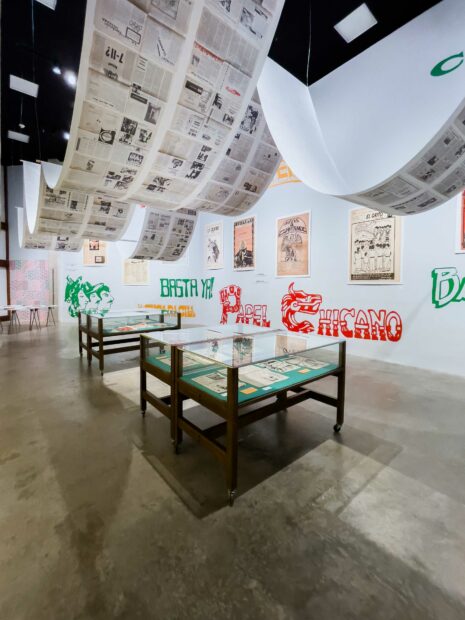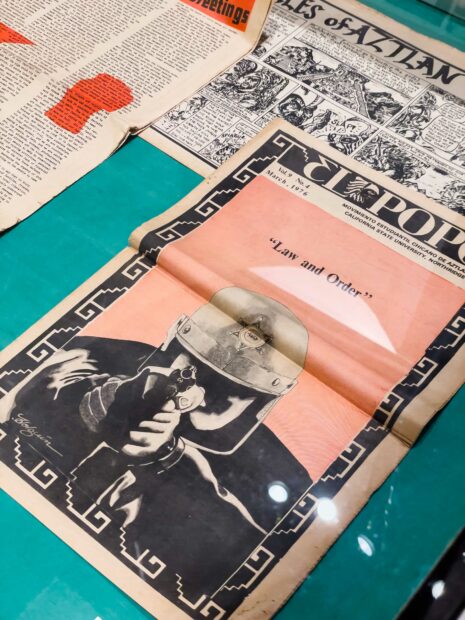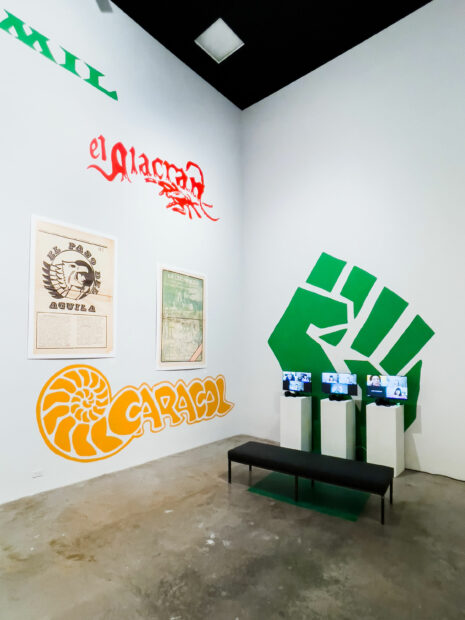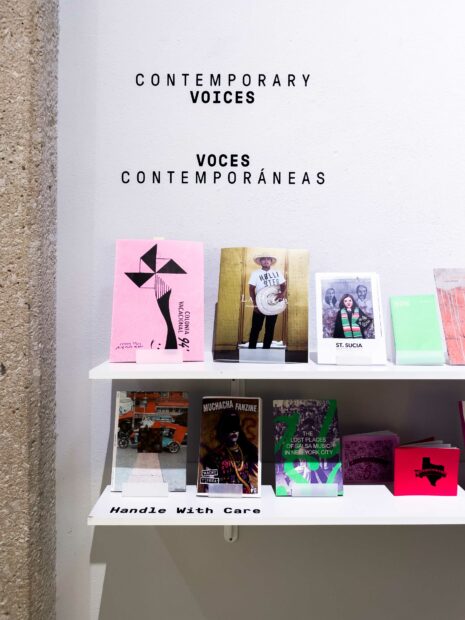
“En El Frente” at the Weil Gallery at the Center for the Arts at Texas A&M University–Corpus Christi.
Years before they co-curated En El Frente, Alexandria Canchola and Joshua Duttweiler independently sought ways to make sense of the chaos and overwhelming misinformation being shared in the political sphere. They began researching the ethics of journalism and looking for historical examples of combating extremist propaganda. Duttweiler took a trip to California, and Canchola went to the Rio Grande Valley; each found inspiration in Chicano independent publications of the 1960s and 70s. This was the impetus for their exhibition En El Frente, which includes historical artifacts, enlarged graphic designs, multimedia installations, and a collection of modern day zines.

“En El Frente” at the Weil Gallery at the Center for the Arts at Texas A&M University–Corpus Christi
The publications featured in the exhibition are original editions found in Texas A&M University–Corpus Christi’s archives, on loan from private collections, or bought online. Reading the articles in the 50 to 60-year-old papers, they felt simultaneously dated and contemporary, universal and local. One of the articles reported on a curriculum and facilities debate in a school-board meeting. Another detailed recent Supreme Court rulings on civil rights issues. It reminds the viewer that every step forward comes with a half-step backwards.
“It’s almost heartbreaking,” says Duttweiler. “The details may be different, but the fight is the same as today. They were fighting for equal representation, immigration reform, and the rights of workers.”
And yet Canchola and Duttweiler seemed optimistic surrounded by the flashy graphics on the walls of the exhibition.

“En El Frente” at the Weil Gallery at the Center for the Arts at Texas A&M University–Corpus Christi.
Both assistant professors of art in graphic design, Canchola and Duttweiler fell in love with the energetic typography and linguistic density of the publications. In designing the exhibition space, they recreated that energy. Above your head hang long sheets of paper, covered in reproductions of the publications. They are draped to mimic a newspaper press, making the gallery feel like it is in motion. On the wall, names of the publications are stenciled like graffiti, and enlargements of some of the pages are plastered guerilla, wheat paste, street-art style. The original publications are displayed under glass in the middle of the room. They are too fragile to handle (except for a few that viewers are allowed to touch).
“Every page in these publications is a work of art, but the artifacts themselves are really precious. This was our way of highlighting the interesting parts without damaging the paper,” says Canchola.
The goal of the curators’ research was to find inspiration in the past to influence the art of today. Social media seems to partially fill the role of the independent publications. Facebook and X (formerly Twitter) are both platforms to discuss local and global issues and give space to independent artists. But it’s not quite the same. Where social media yells into an overcrowded room, the publications spoke loudly and clearly to a smaller community. The authors knew their audience well, and the stories and art were carefully curated for a small group. Social media has its purpose, but it will never replace the bespoke creations that were these independent publications.
“There’s something beautiful about holding an object that is filled with art and created for a community that the publishers clearly loved,” says Duttweiler. “Especially in contemporary times where everything is online, it makes tangible objects more precious.”

“En El Frente” at the Weil Gallery at the Center for the Arts at Texas A&M University–Corpus Christi.
The modern-day zines in the exhibition were collected by the curators as a way to show the evolution of the art form. These zines have less community news than their historical counterparts. Instead, the pages are full of poetry, art, photography, and personal essays. In looking through them, they feel like descriptions of niche cultures. There were some that were about skater culture in urban areas, while others discussed Latinx politics and culture. There may not have been articles about school board meetings, but they were as “of the community” as the older publications.
In creating this exhibition, Canchola and Duttweiler explain that their one goal was for everyone to leave energized, as inspired as they were when doing the research.
“The creators of the independent publications of the 60s and 70s didn’t start out as experts of their craft. They learned the media as they created it,” says Canchola. “There was a real spirit of DIY-ing it. When the publishers didn’t have art for the covers, they called up their local artist friends to fill the space. They took risks.”
Art, like fashion trends and politics, moves in cycles. Like Canchola and Duttweiler, I was moved by this exhibition of the Chicano independent publications of the 60s and 70s. In a world of “millennial gray” and “quiet wealth,” the bold graphics and messages reminded me that complacency is a luxury of the privileged. Not all art is activism, but the best art doesn’t just sit back when the community needs help.

“En El Frente” at the Weil Gallery at the Center for the Arts at Texas A&M University–Corpus Christi.
The opening reception for the exhibition was on Thursday, September 28 at the Weil Gallery, located in Center for the Arts at Texas A&M University–Corpus Christi. The reception included a panel with two activist-designers who worked on the Chicano publications, Carlos Marentes and Jesus Medel, as well as Natasha Hernandez and Isabel Ann Castro, co-editors of St. Sucia a San Antonio based independent publication collective.
En El Frente is on view until October 6, 2023, at the Weil Gallery at the Center for the Arts at Texas A&M University–Corpus Christi.


